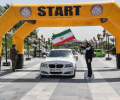RACT TASMANIA LEADS LONG-TERM MOBILITY VISION TO SHAPE HOBART’S FUTURE
Tasmania’s peak motoring authority has seized an opportunity to shape the future of the state’s capital city through a holistic, long-term mobility vision.

According to the Australian Bureau of Statistics, Hobart has the highest percentage of car use of all Australian capitals during weekday commutes, with 84% of residents taking a private vehicle to work.
Australian Automobile Association research also shows that Hobart is the fourth most congested city after Melbourne, Sydney and Adelaide, based on the percentage of drivers travelling at free flow speeds.
These issues have arisen in line with significant growth, with the government predicting Greater Hobart’s population to rise from 230,000 to 300,000 by 2050.
This is why the Royal Automobile Club of Tasmania (RACT) has taken the lead on these issues and formulated a 30-year Greater Hobart Mobility Vision.
Released in April, the RACT’s Vision was formulated through in-depth research, stakeholder and community consultation and external expertise over an eight-month period.
The Vision covers six pillars, including urban planning, engineering, future mobility, social and economic impacts and public and active transport.
Public consultation consisted of a submission process that received 70 submissions, two community surveys with more than 2,600 responses, extensive stakeholder engagement and a public forum.
A panel of five independent experts were also engaged to help develop the Vision and assisted RACT to outline five possible “scenarios” for Greater Hobart.
These included Predict and Provide (quick fixes), Build (infrastructure projects), Mode Shift (active and public transport), Overhaul (overhaul of transport network and adoption of future mobility principles) and River City (ferry network along Hobart’s River Derwent).
Following the forum and public consultation, RACT ultimately supported a hybrid version of Scenarios 3, 4 and 5 incorporating: a settlement strategy that encourages densification around public transport and urban centres; public transport prioritisation and incentives, park and ride, and innovative public transit options; an active travel spine and outlying connections; electric and autonomous public transit, Intelligent Transport Systems and ‘Mobility as a Service’ principles; a ferry network to better utilise the River Derwent.
The consideration of infrastructure projects if Hobart’s use of alternate transport modes, from the private vehicle, rises from 16% to 20% in the first decade of the Vision.
The Vision, which also underwent engineering and economic feasibility, has received overwhelming support from the Tasmanian Government, councils, stakeholders and the community.
RACT will now lobby all levels of government to advocate for projects outlined in this Vision. The Vision, as well as a launch video, can be viewed at hobartvision.ract.com.au.
By Alex Luttrell

 Facebook
Facebook Twitter
Twitter






